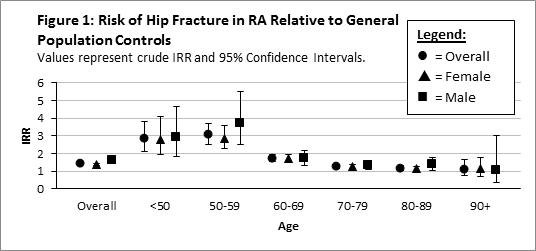Session Information
Session Type: ACR Poster Session A
Session Time: 9:00AM-11:00AM
Background/Purpose: Hip fractures have serious long-term effects, including a high 1-year mortality rate (usually 20-30%) and poor functional recovery, with approximately 50% not attaining pre-fracture functional status. Although risk of hip fractures is known to be increased in rheumatoid arthritis (RA), few studies specifically look at the incidence of hip fractures in patients with RA compared to general population controls. We estimated the incidence of hip fractures in a population-based cohort including all incident RA cases in a Canadian province, using administrative health data.
Methods: Using physician billing data and a previously published RA definition, we assembled an incident cohort of all cases with RA onset between 1997 and 2009. Controls (with no diagnosis of RA or other inflammatory arthritis) selected randomly from the general population were matched 2:1 to RA patients on birth year, gender and index year. RA and controls with prior hip fractures, pathological fractures or Paget’s disease were excluded. Hip fractures (ICD9-CM codes 820.0, 820.2; ICD10-CA codes S72.0, S72.1, S72.2) were identified using hospitalization data (includes ≤25 codes defining reason for admission or complications during hospitalization). Crude incident rates were calculated as number of new hip fractures per person-year (PY). Cox-regression models were used to compare age and sex adjusted risk of hip fracture in RA relative to controls.
Results: A total of 60,101 RA patients and 120,462 controls (mean age 57.2 yrs; 68% females for each cohort) were followed to December 2014, yielding 0.596 million PY and 1.23 million PY, resp. Incident hip fractures were observed in 2463 RA and 3566 controls. Mean (SD) age at time of fracture was 78.9 (10.9) yrs in RA and 82.1 (9.0) yrs in controls. Crude incidence rate was 4.1 and 2.9 per 1000 PY for RA and controls, resp., yielding an incidence rate ratio (IRR) of 1.42 [95% CI 1.35, 1.50]. Crude IRRs decreased with age and did not differ by sex (Figure 1). Adjusting for age and sex, persons with RA had 48% greater risk of hip fracture than persons without (HR 1.48, 95%CI 1.41, 1.56).
Conclusion: Risk of hip fractures in persons with RA is higher than age/sex matched controls particularly at younger ages. Given the impact of hip fractures, this has important implications for functional status and quality of life of people with RA. Further work on course of recovery, mortality and health services use post-fracture is needed.
To cite this abstract in AMA style:
Jones CA, Guy P, Xie H, Sayre EC, Lacaille D. Incidence of Hip Fracture in Rheumatoid Arthritis: British Columbia, Canada [abstract]. Arthritis Rheumatol. 2017; 69 (suppl 10). https://acrabstracts.org/abstract/incidence-of-hip-fracture-in-rheumatoid-arthritis-british-columbia-canada/. Accessed .« Back to 2017 ACR/ARHP Annual Meeting
ACR Meeting Abstracts - https://acrabstracts.org/abstract/incidence-of-hip-fracture-in-rheumatoid-arthritis-british-columbia-canada/

